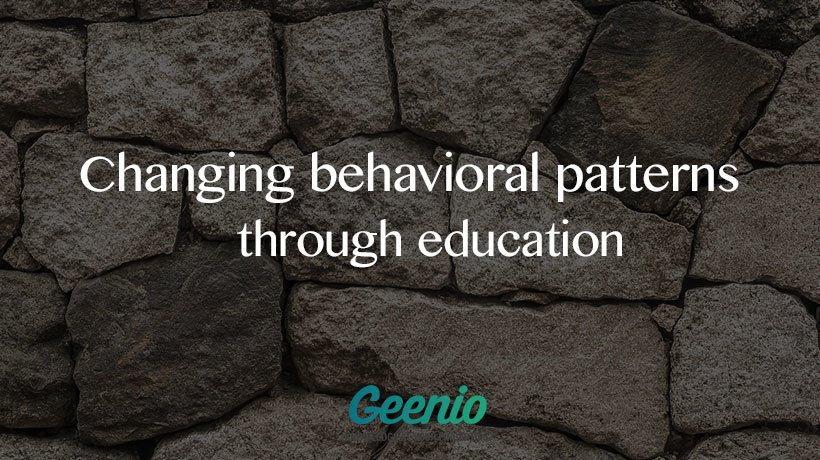Behavioral Patterns: Changing Them Through Education
Fun fact: Whenever you perform the same task, or encounter the same situation a couple of times, your brain inevitably begins forming behavioral patterns specific for the situation or the task at hand. This process is both transparent and essential for a number of reasons. First, it allows you to develop an automated response to recurring stimuli, taking some cognitive load off your brain. Second, behavioral patterns help you save time and effort, as performing a brand new task takes much more time and effort than one you are familiar with. Third, a behavioral pattern gives some assurance that the learned reaction will lead to a favorable outcome - just like it did during past encounters, when the pattern was being formed. Patterns minimize the risk of error, and are generally safer than reacting in a new, unpredictable way.
It is reasonable to conclude that behavioral patterns help us in our everyday lives, and for that reason breaking out of the familiar routine and adopting new patterns of behavior is hard. In this article we will look at the stages a person passes through when his behavior model changes. This will help the eLearning professionals to better understand the students’ psychology and plan the syllabus in such a way as to make the instruction take root and reinforce it as a behavioral pattern in the students’ minds.
Dealing With Bad Habits
In their book “Changing for Good: A Revolutionary Six-Stage Program For Overcoming Bad Habits and Moving Your Life Positively Forward”, J.O. Prochaska, J.C. Norcross, and C.C. DiClemente detail the 6 main stages of dealing with a bad habit. All 6 stages are closely related to the alteration in a person’s behavior connected with the changes in his or her behavioral patterns. Let us examine them:
1. Precontemplation.
At this stage, the person does not recognize the issue connected with his behavior and sees no reason to change it. Sometimes, he may admit the existence of the issue but blame it on external factors or the society at large. At this stage, while the person may alter his behavior under external influence, he will return to the old ways once the influence is gone. Moving to the next stage is only possible when the person begins to earnestly consider the need for change.
2. Contemplation.
At this stage the person recognizes the issue and looks for a way to fix it. He is not yet ready to make conscious effort towards resolution, and merely considers possible solutions. When the person begins to think of the advantages of rejecting the current behavioral pattern, they move to the next stage.
3. Preparation.
This is one of the most important stages, because here the person transitions from a passive to active state and starts making efforts to change his behavior. This usually includes analyzing the current situation, forming an action plan, and proactively considering the possible setbacks he is likely to encounter, as well as ways to overcome them. It is worthy of note that at this stage the person begins expressing commitment to the plan, both to others and to themselves, which further motivates him to reach their goal. If the person skips this stage and proceeds directly to stage four, it is unlikely that the behavioral pattern can be changed, and the chance of the person reverting to his old behavior model is high.
4. Action.
The key stage where the person makes a conscious effort to shift out of the established behavior model. However, merely reaching this stage does not guarantee success. The goal may be reached, but the new behavioral patterns have not yet been reinforced. The person seeks everyday situations that would allow him take advantage of the new behavior model. The new behavioral pattern is being formed at this stage.
5. Maintenance.
A treacherous stage: While the person may believe that they have changed their behavior for good, negative external influence can undo the achieved results. Conflict caused by observing problematic behavior in others can, depending on the individual’s willpower and motivation, either further reinforce the new behavior model or cause a regression to the previous one. It is important to note that unless the new behavior model is successfully reinforced at this stage, the chances of the person reverting to previous behavior are high.
6. Termination.
The peak point and the end goal of the process. At this stage, the old behavioral template has been completely replaced with the new one. Associative chains related to the eradicated bad habit begin to change. The chances of the person reverting to his old behavior model are minimal, as he or she has developed sufficient self-control and no longer requires external support to maintain the new behavior model. When changing a person’s behavior, it is important to understand what stage they are on, and what issues related to the new behavioral pattern they are likely to encounter.
Using This Model In Education
Despite the significant differences between dealing with bad habits and education, the two processes are, in some regards, noticeably alike. Understanding these key points can grant education professionals valuable insight, so let us consider how the principles mentioned above can be applied in our field:
1. You cannot teach a person anything against his will.
If the motivation to learn is not there, the student will not progress, no matter how good the course or the training program.
2. Imparting a new behavior model is hard.
In the majority, people are conservative, and prefer to rely on established behavioral patterns instead of adopting a new behavior model. Be ready that your students may resist change to some degree.
3. People blame their lack of success on external factors and other people first, themselves second.
To change his or her behavior model, the person must recognize and accept personal responsibility for success or failure. Otherwise, no progress is possible.
4. Most people are insecure in their talent and ability.
This leads to them staying in their comfort zone instead of trying to search for more optimal behavior or apply newly acquired knowledge. This presents a problem, as knowledge that is not used is soon forgotten and gone.
5. Many people downplay or deny the effects of problem behavior.
This is true both for bad habits and educational context:
- “Yes, I like having a drink now and then. But I drink way less that some of the people I hang out with”.
- “Even if I had completed the course, it would not have helped me to do my job”.
6. Before engaging in education, a person must mentally prepare for it first.
Before providing instruction, seek to motivate your students and explain to them the advantages they will receive from successfully completing the course or training program.
In conclusion, before engaging in education, students must pass the Precontemplation and Contemplation stages, and enter the Preparation stage. During training, they must pass the Preparation and Action stages. And in conclusion, it is important to focus on the fifth stage (Maintenance) to begin applying the acquired knowledge in a practical way, so that it is retained and becomes a part of the new behavioral pattern.
Changing a person’s behavior model is a long and arduous process. That’s why training courses that aim to truly change the students’ behavior must not merely instruct, but also help the students fight the natural resistance to change.







